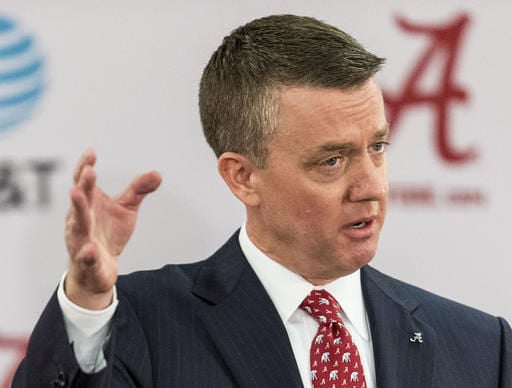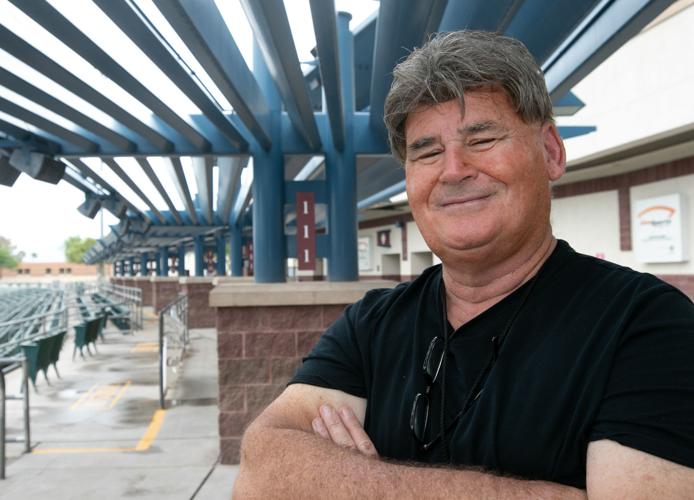Star columnist Greg Hansen checks in with four feel-good storylines in Tucson sports, how coronavirus stopping sports saves money for the UA athletic department, and how one former Pac-12 foe could bolster Sean Miller's staff.
Four feel-good stories in Tucson sports
1. On Senior Day at Hillenbrand Stadium, 2006, senior pitcher Leslie Wolfe capped her softball career by beating Women’s College World Series-bound Oregon State 11-2 with her family in the audience.
“The script was perfect,” said UA coach Mike Candrea.
A few weeks later, the three-time all-state pitcher from Scottsdale Desert Mountain High School closed her UA career with an NCAA championship ring.
Now, 14 years later, Leslie Wolfe Brown is married to Matt Brown, the UA’s assistant athletic director for event management; they have two young children, Brooks and Kamryn.
After her softball career, Leslie graduated from the UA’s nursing school and is now working in the trauma/emergency center at Banner-University Medical Center. She works three 12-hour shifts per week, 7 a.m. to 7 p.m.
“Leslie is very active in the organ donor network as well as handling emergency and trauma cases, which include COVID-19 patients,” said Wendy Foss, also a trauma/ER nurse at Banner. (Full disclosure: Wendy is my stepdaughter).
“We’ve been taking care of some super-sick patients. We go to extreme lengths to make sure we are protected and stay safe. On some days, we see as many as 150 patients. We start with 10 to 12 nurses at 7 a.m., and routinely add two more at 10 a.m., two more at noon and another two at 3 p.m. It can get really intense. Leslie is really good at what she does.”
The Pac-12 Networks will broadcast an interview with Leslie on its Pac-12 Playlist segments that begin Monday evening and will be rebroadcast through the week.
Leslie was one of the nation’s top softball recruits in 2002. She had offers to pitch for powers Tennessee and Florida before ultimately choosing Arizona, but her impact in Tucson has gone far beyond striking out softball players.
2. When members at the Ventana Canyon Golf & Racquet Club became aware that it would need to furlough employees, or shorten hours and even terminate positions due to financial challenges brought on by COVID-19, volunteers from the scenic golf course quickly stepped up to help.
The governing body of the club appealed to the total membership for volunteer financial contributions. In less than two weeks, about $100,000 was raised for an employees fund. By this weekend, it had grown to $150,000.
The golf and tennis club, which remains fully operational, maintains social-distancing guidelines prescribed by national and state leaders. It has also created a grocery delivery service and carry-out dining service, in which a hotline has been established for breakfast, lunch and dinner delivery to members.
That’s a community success story that goes beyond sports.
3. After a productive basketball career at Rincon/University High School, Dylan Hidalgo was a standout at NAIA Kansas Wesleyan College, where he was named the conference’s Champions Character Student-Athlete of the Year.
He returned to Tucson and became an assistant coach for Brian Peabody at Pima College, helping the Aztecs to a 31-5 record in 2017-18, finishing No. 2 in the NJCAA championships. Hidalgo was then hired by Grand Canyon coach Dan Majerle to be a graduate assistant coach.
Majerle and GCU parted ways six weeks ago, leaving Hidalgo and his wife, Bree, with an uncertain future. Two weeks ago, Dylan and Bree welcomed a baby boy, Baylor, into the world. Talk about good timing; new Grand Canyon coach Bryce Drew then hired Dylan as GCU’s director of basketball operations, in which he will oversee scheduling, budgeting, travel and summer camps.
Good timing, indeed.
4. Arizona grad Jim Furyk, the 2003 U.S. Open champion and key member of the UA’s 1992 NCAA title-winning team, turns 50 next month, which will make him eligible for the PGA Tour Champions circuit. He is apt to play in Tucson’s Cologuard Classic next winter.
Even though the PGA Tour has paused competition, Furyk had his first victory of the year last week and it wasn’t scored on a golf course. He donated $100,000 to Baptist Healthy Foundation’s COVID-19 Emergency Relief Fund for PPE’s near Ponte Vedra, Florida, where he lives.
Furyk and his wife, Tabitha, also are encouraging people to donate through the foundation’s Facebook page.
“We felt like this is what is really needed right now, because this might get worse before it gets better,” Tabitha told Florida reporters. “Doctors and nurses out there who are helping people with the virus don’t have that option of staying at home. If we can give them a safe work environment, every patient has a better chance of survival.”
The Furyks also donated more than 5,000 packages of beef jerky and shipped them to seven schools in North Florida as part of a “Blessings in a Backpack” program to ensure children receive healthy food during the weekends when they’re away from school.
Arizona’s athletic department saves on travel with sports canceled

Hillenbrand Stadium sits empty and locked in the middle of what should be the Arizona Wildcats softball season, one of many closures, locally and nationally, due to COVID-19 distancing measures, March 18, 2020, Tucson, Ariz.
If about 35 seniors in Arizona’s Class of 2020 return for an NCAA-approved extended senior season in 2021, it could cost the UA athletic department in excess of $400,000 in scholarship costs.
But that expense would be mitigated by the absence of travel costs this year in baseball, softball, track, beach volleyball, tennis and golf.
For example, coach Jay Johnson’s UA baseball team was scheduled for five three-day road series, at Washington, USC, Oregon, Cal and Utah. That’s about $20,000 per trip, given airline, lodging, ground transportation and food expenses. That’s roughly $100,000 that won’t be spent.
Mike Candrea’s softball team had weekend series scheduled at Stanford, ASU, Oregon and Washington, and Fred Harvey’s men’s and women’s track teams had three competitions scheduled in California and two in Oregon. Combined, the UA’s spring sports had 31 trips and about 300 nights in hotels scheduled.
Plus, the UA spends a significant amount in spring football recruiting visits by Kevin Sumlin and his staff.
That lack of spring expenses is about the only positive in the developing budget crisis for every athletic department in college sports.
Learfield IMG College — the body that operates Arizona’s sponsorships, signage, advertising and multimedia income — has about 2,200 total employees in college sports. Last week, IMG announced a plan to reduce salaries and furlough workers, although none specific to the UA.
Developing financial issues on campus aren’t unique to athletic departments. Refunds for tuition, room and board charges, the potential cancellation of summer school classes — imagine how much money the UA no longer realizes day to day from its massive parking garages — will strongly impact Arizona’s cash flow far beyond football and basketball.
Conference's cancellation affects former UA AD Byrne

Greg Byrne speaks during a news conference after being introduced as Alabama’s new athletic director, Thursday, Jan. 19, 2017, at Naylor-Stone Media Suite in Tuscaloosa, Ala. (Vasha Hunt/AL.com via AP)
While the athletic director at Arizona, Greg Byrne was voted to be third vice president of the National Association of Collegiate Directors of Athletics. It was a meaningful honor to Byrne, whose father, Bill Byrne, had served as 1992 NACDA president while he was AD at Nebraska. Greg Byrne worked his way up to NACDA president this year, a role highlighted by the annual NACDA convention, scheduled June 7-10 in Las Vegas. The convention was canceled last week. It’s uncertain whether Byrne’s term will be carried over to 2021.
Aari McDonald joins elite company

Arizona guard Aari McDonald (2) high-fives fans as she enters the court during player intros prior to Arizona's 55-54 loss to California at McKale Center in Tucson, Ariz., on March 1, 2020.
Arizona point guard Aari McDonald last week was selected as winner of the Ann Meyers Drysdale Award as the top shooting guard in women’s college basketball. The two previous recipients were Oregon All-American Sabrina Ionescu and Washington’s career scoring leader Kelsey Plum, two of the best players in Pac-12 history. UConn guards won eight of the Drysdale awards since its inception in 2000. In short, it’s the kind of honor that leads to having your jersey put on display on the wall at McKale Center with the Sean Elliott's and Steve Kerr's.
Blake Martinez builds personal compound in Tucson

Former Canyon del Oro star Blake Martinez signed a three-year, $30 million contract with the New York Giants.
After former Canyon del Oro High School and Stanford linebacker Blake Martinez signed a $30 million free agent contract win the New York Giants last week, he was working out at a 15,000-square-foot steel building that his father, Tucson contractor Marc Martinez, built over the last 11 months. As reported by my former Star colleague Zack Rosenblatt of NJ.com, Martinez lives in the new building with his wife, Kristy, and their 20-month-old daughter, Kinsley.
The compound includes a turf surface on which he can do sprinting workouts, a basketball court, sauna, massage table and play area. Upstairs is a near-4,000 square-foot living space. Former Arizona tight end Glenn Howell, part of the UA’s football radio pregame and postgame broadcasts, is Martinez’s personal trainer while he’s in Tucson.
Kino Baseball League takes dent from coronavirus outbreak

Bill Leith, president of Sun Belt Baseball and a half-dozen other youth baseball ventures poses for a photo at Kino Sports Complex on July 10, 2018 in Tucson, AZ.
One of the potential Tucson sports casualties of the coronavirus pandemic is the vast Kino Summer Baseball League operation. Bill Leith, president and founder of the league, said that he still hopes to start play in June or early July. “Registration for the college league has been surprisingly steady considering the circumstances,” said Leith. Last year, the Kino baseball league had 57 teams, 932 players and played 307 games. It’s not just a skin-of-your-teeth operation. Leith said that it costs about $180,000 last year to pay for field rentals, lights, umpires, trainers, security and insurance.
My two cents: Wildcats could hit home run if they lure Brandon Roy from Pacific Northwest

Nathan Hale head coach Brandon Roy, left, celebrates with center Jontay Porter (11) after Nathan Hale defeated Garfield in the Washington state boys' 3A high school basketball championship, Saturday, March 4, 2017, in Tacoma, Wash. (AP Photo/Ted S. Warren)
When ESPN rebroadcast Arizona’s 1997 NCAA championship victory over Kentucky last month, camera close-ups of the UA bench were a reminder of the way things used to be.
Lute Olson’s assistant coaches Jim Rosborough, Jessie Evans and Phil Johnson engaged with players and one another, often consulting Olson before and during timeout huddles.
All of that game-day interaction has changed over the years at Arizona. Assistant coaches at the UA are no longer on a first-name basis with the community.
Unlike Pac-12 coaches Larry Krystkowiak of Utah, Mike Hopkins of Washington, Dana Altman of Oregon and UCLA coach Mick Cronin — all seen interacting with assistants during timeout chats — Arizona’s Sean Miller often appears to fly solo.
When assistant coach Justin Gainey left Arizona to coach at Marquette last week, a few people asked me “which one was Gainey?” Such is the way Miller chooses to operate his basketball program; assistant coaches are low-profile figures.
Even when Miller employed former Washington head coach Lorenzo Romar for a season, Romar remained low key and was rarely seen involved with UA players during a game.
Hey, it worked for Indiana’s Bob Knight a generation ago. One coach. One voice.
Miller is now searching to replace Gainey. Given the UA’s unsettled issues with an NCAA investigation and an uncertain future, it’s intriguing to picture what type of assistant coach would be willing to replace Gainey.
An absolute home run hire would be Seattle’s Garfield High School coach Brandon Roy, the 2006 Pac-10 Player of the Year with the Washington Huskies. If you recall, Roy first committed to play at Arizona in 2002 before a late change of direction.
Seattle is the West Coast’s No. 2 basketball recruiting turf, and Roy’s name is gold in Seattle. The three-time NBA All-Star has coached three state championship teams in the last four years in Washington and, at 35, might be ready to leave for a college job. Current recruits know who Roy is.
But getting Roy to Arizona is unlikely. He’s got four children between ages 2-12, and Seattle is home. He recently told The Athletic “it’s our little utopia. … I’m in a good, positive space.”
The man Miller hires will be an on-the-clock recruiter, a behind-the-scenes, on-the-road grinder involved in the UA basketball operation 24/7. That’s probably not the path a man with four young children and $82 million in NBA career earnings is apt to pursue.











